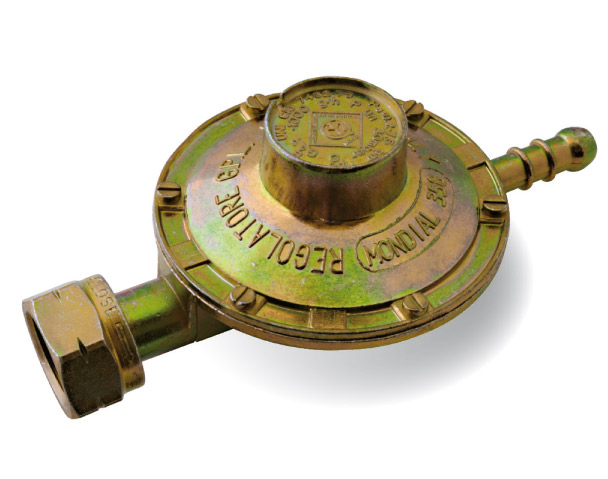The use of pressure regulators in oxyacetylene welding

What is oxyacetylene welding?
Oxyacetylene welding represents the welding technique in which the energy is produced by combustion in equal parts of acetylene and oxygen.This methodology, discovered in 1895, was the most used during the first decades of the twentieth century, before being replaced by other more innovative technologies, such as arc welding. However, even today, it is widely used in some workshops and for welding in points where it is not possible to have electric power.
The instrumentation of oxyacetylene welding
The classic equipment for this type of welding is composed of the following elements:
- Oxygen cylinder: the cylinders contain a volume of oxygen proportional to the pressure and have, at the top, a valve with right-hand thread, to which the pressure regulator is screwed.
- Acetylene cylinders: to avoid explosion problems, acetylene is usually dissolved in acetone and not compressed. Furthermore, the cylinder is filled with porous masses which absorb the acetylene. Also for this cylinder, on the top there is a valve to which the pressure reducer or regulator is screwed.
- Pressure regulator or reducer: oxygen and acetylene, extracted from the cylinders, must have a lower and constant pressure, regardless of the flow rate. This is the main purpose of these components, as we will see in the next paragraph.
- Safety valves: they have the task of avoiding backfire, a highly dangerous phenomenon for the health of the welder.
- Economizer: it is a classic element of fixed stations and has the task of allowing the inflow of the two gases only during welding, blocking it when it is not required.
- Flexible rubber hoses: allow the welder an adequate flame mobility.
- Torch: it is the terminal element of the equipment and determines the mixing between the combustible gas and the combustive gas, ensuring a regular combustion at the exit from the tip.
What are the features of pressure regulators?
Pressure regulators play a fundamental role in the equipment for oxyacetylene welding. The most important features of these elements are:1. First of all supply a constant pressure and, in general, lower than that of the cylinders of origin of the two gases concerned.
2. Allow the regulation of the pressure to the values of interest for carrying out the operation.
3. To guarantee a certain level of security.
The pressure regulators or reducers are also anticipated and followed by two pressure gauges which respectively measure the pressure in the cylinders and the pressure at the outlet of the regulator. The reference standard for the realization of these elements is the UNI EN ISO 2503 standard: "Pressure reducers for gas cylinders used in welding, cutting and related processes up to 300 bar".
Principle of operation of the pressure regulators
This component is divided into two chambers: a low pressure chamber and a high pressure chamber. When the gas tap is opened on the torch, a depression is generated which causes the membrane to flex under the effect of the spring. This determines the opening and the communication between the two chambers, generating the escape of the gas from the high pressure chamber towards the low pressure one. With the closure, the procedure is the opposite, with the pressure that determines the return of the membrane in its initial position and the interruption of the inflow of gas from the high pressure chamber towards the one with a lower pressure.
Damage and danger of pressure regulators in oxyacetylene welding
Since these elements are in close contact with highly inflammable gases, particular care must be taken in manufacturing and maintenance. As always, proper maintenance extends the life of the component and reduces the risk of possible accidents. In particular, the materials used are self-lubricating, since the lubricants otherwise necessary, are flammable and can lead to problems of fire and explosion. Another problem is that of the frost that can be created inside the component near the needle. Obviously, to overcome this problem it is highly discouraged to use a flame to raise the temperature and cause the thaw. Therefore, the possible remedies can be: the use of a heat exchange circuit between gas and water or the use of heating cloths.Copper is a very dangerous and reactive element with acetylene, since it forms a compound called "copper acetyl" which is explosive. For this reason, the UNI EN 29539 standard (ISO 9539) requires that the metal pipes for tubes, the fittings and the materials with which the gas can come into contact (for example the pressure regulators or reducers), contain a percentage of copper less than 70%. Furthermore, it is requested, always in this legislation, to avoid copper in metal flame arrest devices. The most important aspect is that acetylene should not be used for equipment designed for other types of gas, as the problems described above can take over.
Main aspects of pressure regulators for oxyacetylene welding
As already discussed in the previous paragraphs, the role of pressure regulators is a fundamental role in the apparatus concerning oxyacetylene welding. These devices offer the possibility to easily regulate the pressure and also keep it constant on the value set for the period necessary for welding. In addition, the safety guaranteed by these devices must be maximum, because a failure can have serious consequences both to the components to be welded and to the operator who carries out the welding. The design and maintenance of these devices must be carried out very carefully and by properly trained personnel.15/03/2019
I contenuti di questo sito non hanno carattere di periodicità e non rappresentano 'prodotto editoriale'.








